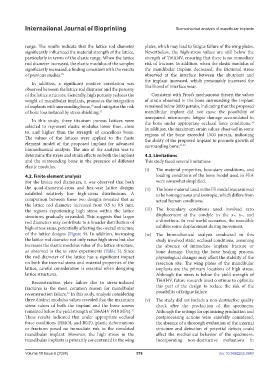Page 586 - IJB-10-6
P. 586
International Journal of Bioprinting Biomechanical analysis of mandibular implants
range. The results indicate that the lattice rod diameter plates, which may lead to fatigue failure of the wing plates.
significantly influenced the material strength of the lattice, Nevertheless, the high-stress values are still below the
particularly in terms of the elastic range. When the lattice strength of Ti6Al4V, ensuring that there is no immediate
rod diameter increased, the elastic modulus of the samples risk of fracture. In addition, when the elastic modulus of
significantly increased, a finding consistent with the results the mandibular implant decreased, the frictional stress
of previous studies. 29 observed at the interface between the abutment and
the implant increased, which presumably increased the
In addition, a significant positive correlation was
observed between the lattice rod diameter and the porosity likelihood of interface wear.
of the lattice structure. Generally, high porosity reduces the Consistent with Frost’s mechanostat theory, the values
weight of mandibular implants, promotes the integration of strain observed in the bone surrounding the implant
30
of implants with surrounding bone, and mitigates the risk remained below 3000 µstrain, indicating that the proposed
of bone loss induced by stress shielding. 31 mandibular implant did not cause the possibility of
unrepaired microscopic fatigue damage accumulated in
In this study, three titanium porous lattices were the bone under appropriate occlusal force conditions.
34
selected to represent elastic modulus lower than, close In addition, the maximum strain values observed in some
to, and higher than the strength of cancellous bone. regions of the bone exceeded 1500 µstrain, indicating
The values of the lattices were applied to the finite the ability of the proposed implant to promote growth of
element model of the proposed implant for advanced surrounding bone. 34,35
biomechanical analysis. The aim of the analysis was to
determine the stress and strain effects on both the implant 4.3. Limitations
and the surrounding bone in the presence of different This study faced several limitations:
elastic modulus.
(i) The material properties, boundary conditions, and
4.2. Finite element analysis loading conditions of the bone model used in FEA
For the lattice rod diameters, it was observed that both were somewhat simplified.
the quad-diametral-cross and hex-vase lattice designs (ii) The bone material used in the FE model was assumed
exhibited relatively low high-stress distributions. A to be homogeneous and isotropic, which differs from
comparison between these two designs revealed that as actual human conditions.
the lattice rod diameter increased from 0.5 to 0.9 mm,
the regions experiencing high stress within the lattice (iii) The boundary conditions used involved zero
structures gradually expanded. This suggests that larger displacement at the condyle in the x-, y-, and
rod diameters may contribute to a broader distribution of z-directions. In real-world scenarios, the mandible
high-stress areas, potentially affecting the overall structure exhibits some displacement during movement.
of the lattice designs (Figure 9). In addition, increasing (iv) The biomechanical analysis conducted in this
the lattice rod diameter not only raises high stress but also study involved static occlusal conditions, assuming
increases the elastic modulus value of the lattice structure, the absence of immediate implant fracture or
as observed in the in vitro experiments (Table 3). Since bone damage. During the bone healing process,
the rod diameter of the lattice has a significant impact physiological changes may affect the stability of the
on both the internal stress and material properties of the resection site. The wing plates of the mandibular
lattice, careful consideration is essential when designing implants are the primary locations of high stress.
lattice structures. Although the stress is below the yield strength of
Reconstruction plate failure due to stress-induced Ti6Al4V, future research must continue to optimize
fractures is the most common reason for mandibular this part of the design to reduce the risk of the
reconstruction failure. In this study, analysis considering possibility of fatigue failure.
32
three distinct modulus values revealed that the maximum (v) The study did not include a non-destructive quality
stress values of both the implant and the bone screws check after the production of the specimens.
remained below the yield strength of Ti6Al4V (910 MPa). Although the settings for optimizing production and
33
These results indicated that under appropriate occlusal postprocessing actions were carefully considered,
force conditions (RMOL and RGF), plastic deformations the absence of a thorough evaluation of the internal
or fractures posed no immediate risk in the simulated structure and detection of potential defects could
mandibular implant. However, the high stress in the affect the mechanical behavior of the specimens.
mandibular implants is primarily concentrated in the wing Incorporating non-destructive evaluations in
Volume 10 Issue 6 (2024) 578 doi: 10.36922/ijb.3943

